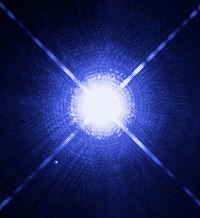
Photo from wikipedia
Double white dwarfs (DWDs) will be the most numerous gravitational-wave (GW) sources for the Laser Interferometer Space Antenna (LISA). Most of the Galactic DWDs will be unresolved and will superpose… Click to show full abstract
Double white dwarfs (DWDs) will be the most numerous gravitational-wave (GW) sources for the Laser Interferometer Space Antenna (LISA). Most of the Galactic DWDs will be unresolved and will superpose to form a confusion noise foreground, the dominant LISA noise source around ∼0.5–3 mHz. A small fraction of these sources will stand out from the background and be individually detectable. Uniquely among GW sources, a handful of these binaries will be known in advance from electromagnetic (EM) observations and will be guaranteed sources of detectable GWs in the LISA band; these are known as verification binaries (VBs). High-cadence photometric surveys are continuously discovering new VB systems, and their number will continue to grow ahead of the launch of LISA. We analyse, in a fully Bayesian framework, all the currently known VB candidates with the latest design requirements for the LISA mission and find that 25 of the considered sources can be detected within a four year observation time. We explore what can be expected from GW observations, both alone and in combination with EM observations, and estimate the VB’s time to detection in the early months of LISA operations. We also show how VBs can be analysed in the case where their GW signals compete with many other unknown binary signals (both resolved and unresolved) from a realistic Galactic population of DWDs.
Journal Title: Monthly Notices of the Royal Astronomical Society
Year Published: 2022
Link to full text (if available)
Share on Social Media: Sign Up to like & get
recommendations!